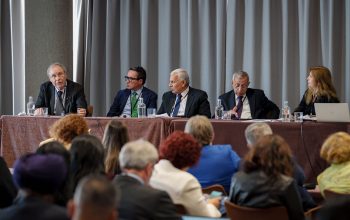news
“Clash of Conventions”, an article by Dr. Leonel Fernández
August 8, 2016
At the end of the Republican National Convention in Cleveland on July 21, alarm bells started ringing in certain quarters. For the first time, Donald Trump, the eccentric businessman chosen as the Republican presidential nominee, was leading in the polls over his Democratic Party rival, Hillary Clinton.
This is what usually happens at the end of a convention – obviously due to the spectacle of the event, the heavy media scrutiny of the speeches,
and the official selection of the person who could become the next resident of the White House. All this hullaballoo makes each party’s convention the unshakeable center of public attention for several days.
The same thing happened a week later when the Democratic National Convention in Philadelphia wrapped up on July 28. Suddenly Hillary Clinton, the first woman nominated as a presidential candidate by a mainstream party in the United States, had again
eclipsed Trump to lead in the polls.
In recent days, due to a rash of errors by Trump that have flung him into fights on various fronts, Hillary has expanded her lead over the Republican challenger.
According to most current polls, if the U.S. election were held today, Hillary Clinton would have an 85% chance of winning.
Conflicting Visions
For Trump, the United States is living one of the worst moments
in its contemporary history. He places the fault for this decline on migration, free trade, offshoring, deindustrialization, the disappearance of jobs, and erroneous policies on climate change and energy as well as security, defense, and foreign policy.
In terms of immigration, he says he will build a wall between Mexico and the United States, paid for by the southern neighbor, to keep that country’s citizens – many of whom, according to Trump, are nothing more
than drug addicts and rapists – from continuing to cross into the U.S. illegally.
He would prohibit entry to Muslims, expel all Syrians currently in the country, and immediately deport the country’s 11 million undocumented immigrants.
He has accused China of cheapening its export products with subsidies, of manipulating its currency (the yuan), and of fostering intellectual property theft.
He has said that if China
won’t accept the new rules of the game under his administration, he will levy a tax on all Chinese imports to the United States, implying a return to protectionism.
He also plans to reduce the tax on U.S. corporate profits, reduce the national debt with spending cuts, overturn Obamacare, and penalize firms who won’t return their production to U.S. soil. He has questioned the role of the North Atlantic Treaty Organization (NATO) as the ideal body for
post–Cold War defense and argued in favor abandoning traditional alliances and shoring up U.S. military clout, while emphasizing the need to get rid of ISIS.
For her part, Hillary Clinton believes that since the outbreak of the 2008 global financial crisis – the deepest and most severe since the Great Depression of the 1930s – the United States has been progressing.
As evidence she points to the 15 million new jobs created in the last eight years, the
annual GDP growth rates above 2%, the reduction in the deficit, the 20 million U.S. citizens who now have access to a health insurance system, and a recovering automotive industry that had been on the brink of collapse.
In terms of migration, her conviction is that this issue involves family unity and thus instead of being deported, the country’s 11 million currently undocumented immigrants should have their presence legalized with a reform to the migration
system.
Instead of reducing taxes on corporate profits, which in fact never trickle down to the lower classes – contrary to what has been believed since the Reagan era – she suggests raising the minimum wage from $7.25 to $15 per hour.
Her basic aim is to reduce social inequality, the most crucial problem plaguing contemporary U.S. society; to improve productive capacity, innovation, and infrastructure development; and to protect domestic
security and make the world safer and more sustainable for future generations.
In short: to pursue policies of dialogue and cooperation with China and Russia, as well as containment when necessary; to fight terrorism; to strengthen regional alliances, especially in the Pacific and the Middle East; and to support NATO as the primary organ of transatlantic security.
Profile of the Electorate
The way the presidential
primaries played out in both parties offers an unequivocal sign of the simmering discontent that now prevails in the U.S. electorate. There is a sort of mutiny against the traditional establishment. Donald Trump’s own candidacy is proof of that, as was the notable support received within the Democratic ranks for senator Bernie Sanders.
The malaise has its roots in the attitude of Washington politicos towards the negative effects of globalization on certain parts
of the U.S., basically concerning international trade, offshoring of firms, job losses, and chronic social inequities.
To this mix we must add the new wave of racism, xenophobia, and violence; changes in demographic composition; cultural shifts, especially on issues of gender and sexuality; and the use of social networks to air age-old social grievances, which has inflamed anguish, anxiety, and dissent in U.S. society.
In the face of this panorama, the
U.S. electorate is splintered, both territorially over the country’s different regions and across the social strata of the different groups of voters.
The Democratic Party, with the presidential and vice-presidential candidacies of Hillary Clinton and Tim Kaine, dominates in the Northeastern and Pacific coastal states. It’s also preferred amongst young voters, women, whites with higher levels of education, Latinos, blacks, and Asians.
For
their part, the Republicans, represented by Donald Trump and Mike Pence, enjoy a majority in the South, Midwest, and most of the Rocky Mountain States. Its social base is made up of white working-class voters, businessmen, religious groups (especially Catholics and evangelicals), and conservative movements.
But in the United States, as you’ll recall, what decides the result of presidential elections is not the popular vote but the so-called electoral college,
made up of the sum of each state’s two senators and its number of congressional representatives.
As voter polarization is inevitable in each electoral cycle, the final vote will be decided by what happens in a small number of key states, called swing states. These currently include Pennsylvania, Ohio, Michigan, Wisconsin, Florida, Georgia, Iowa, Missouri, North Carolina, Maine, and Nevada – and in every one of these arenas where the great U.S. electoral battles
will play out, Hillary Clinton currently leads in the polls.
It could well be the case that this electoral repositioning by Hillary is being influenced by the personality and temperament of Donald Trump, who appears erratic and incoherent.
But likewise, it may be recognition of the labors of President Barack Obama in having maintained economic stability and growth in times of uncertainty, and a portent of what may happen in just three months’
time in the U.S. presidential elections: a triumph for Hillary Clinton.
Related link: http://leonelfernandez.com/articulos/choque-de-convenciones/






